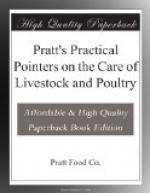[Illustration: HEREFORD BULL]
To carry growing animals through the winter so that they make no increase and in some instances lose weight, to be made up the following summer, is short-sighted policy and wasteful of food. If a stunted condition is allowed at any time, increase is not only retarded, but the capacity for future increase is also lessened.
The pastures for heifers should be abundant, or supplemented by soiling food where they are short. This is specially necessary because the heifers will then be pregnant, and because of the burden thus put upon them in addition to that of growth, certain evils will follow.
In some instances calves are grown on whole milk and adjuncts, and are sold at the age of 6 to 9 months. This is practicable when two or three calves are reared on one cow. The meal adjuncts to accompany such feeding may consist of ground corn, oats, bran, and oil meal, fed in the proportions of, say 4, 2, 1, and 1 parts by weight. In some instances they are kept two or three months longer, and when sold such calves well fattened bring high prices.
The growing of baby beef is coming into much favor. Baby beef means beef put upon the market when it can no longer be called veal and when considerably short of maturity, usually under the age of 24 months. To grow such beef properly animals must be given a good healthy start, growth must not be interrupted and must be reasonably rapid, and the condition of flesh in which they are kept must be higher than for breeding uses. The process is in a sense a forcing one through feeding of relatively large amounts of grain. Though kept in good flesh all the while, the highest condition of flesh should be sought during the latter stages of feeding.
When stall feeding begins, cattle are led up gradually during preliminary feeding to full feeding. Full feeding means consumption of all grain and other food the animal can take without injuring digestion. A lean animal cannot be fattened quickly. Before rapid deposits of fat can occur the lean animal must be brought into a well-nourished condition. Preliminary feeding should cover a period of four to eight weeks in ordinary fattening.
When cattle are to be finished on grass, they are usually fed a moderate amount of grain daily the previous winter. The amount will be influenced by the character of the fodders and by the season when the cattle are to be sold. Usually it is not less than three pounds per animal, daily, nor more than six pounds. Steers will fatten in much shorter time when Pratts Cow Remedy is used. It causes them to quickly put on solid flesh, due to its action on the blood, bowels, and digestive organs.




